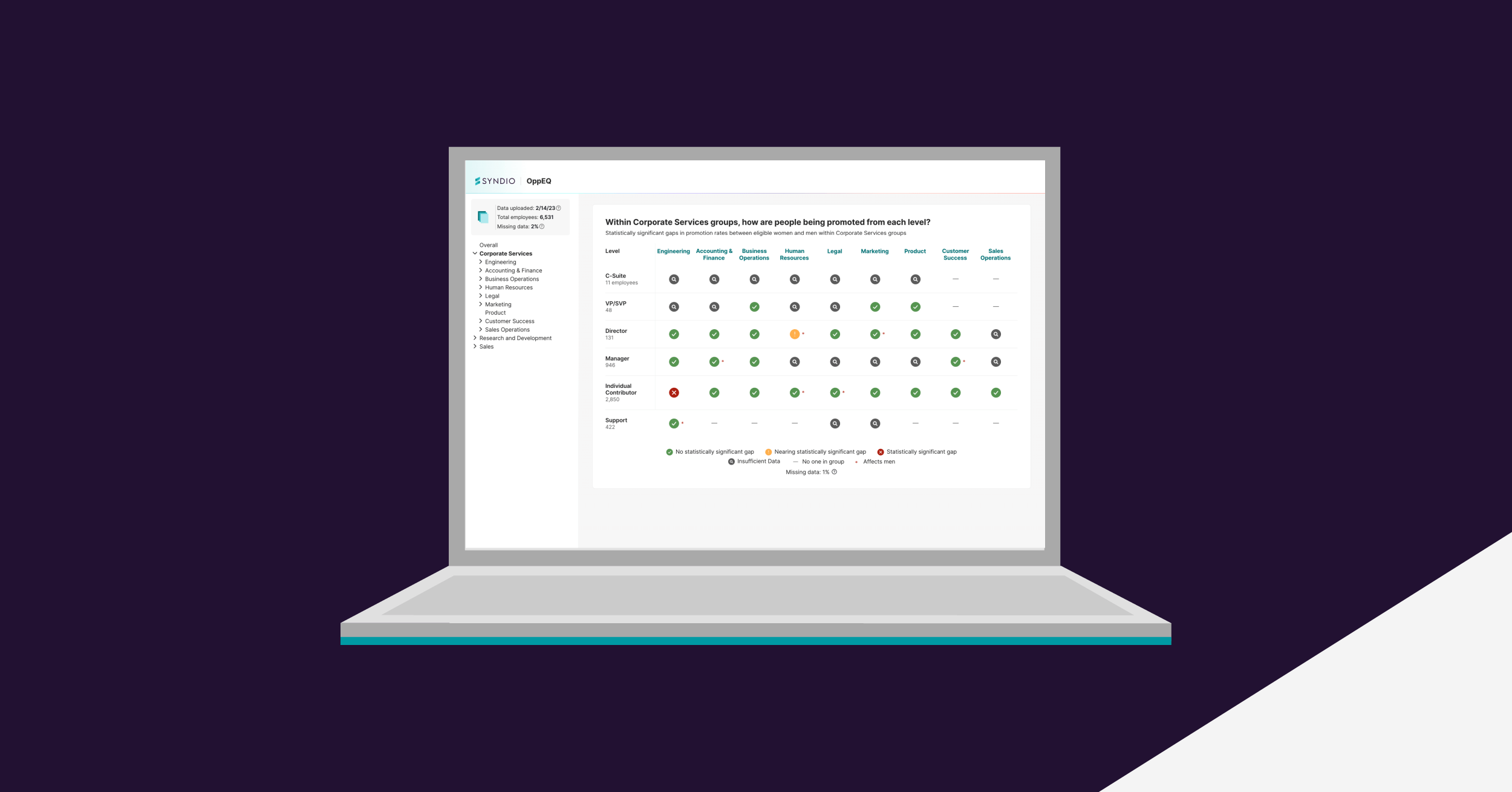Simply put, opportunity equity means that all employees have equal access to opportunities for employment, advancement, and development — regardless of gender, race, or other factors.
But the data show that this is often not what happens.
Some groups of people (typically women, BIPOC employees, and other underrepresented groups) get hired, advance, and stay at the company at lower rates than others — after controlling for factors like availability of talent, performance, and tenure. This means that not all employees have equal access to the same opportunities.
Opportunity disparities increase legal risk and impact employee morale — and ultimately drive lower engagement and higher attrition. They also mean that companies aren’t getting the most out of their human capital investments, directly impacting the bottom line.
When companies do get opportunity equity right, they see better employee retention rates and improved recruiting results, improved problem solving, and better overall performance.
Opportunity equity has become a focus for organizations seeking to reap these benefits as well as prepare for expanding pay transparency legislation. It has only grown more urgent with pressure from a variety of sources.
Why is opportunity equity more important now than ever?
When we talk to executives at leading companies, they cite three top reasons for why they’re focusing on opportunity gaps:
- Competition for talent
- Company performance and investor demands
- Legislative reporting requirements
Let’s unpack each of these driving forces to understand what’s changing and where companies should focus to get ahead of these trends.
Competition for talent
“The war for talent is over and the talent has won.”
— Frank Møllerop, CEO of Tivian
Today’s employees are rejecting the status quo and choosing workplace equity and a healthy work culture over better compensation.
According to the Winter 2022 Fortune/Deloitte CEO Survey, 71% of CEOs name labor/skills shortage as one of their top three concerns this year. It’s no wonder as 47.4 million American workers voluntarily left their jobs in 2021, an all-time record, with no sign of a slow down in the first quarter of 2022.
A report by Josh Bersin found that “fair and equitable pay” came in 6th in a list of 83 practices ranked by their impact on business, innovation, and people outcomes. “Above-average compensation” came in 75th.
Company performance and investors
“We have seen how purposeful companies, with better environmental, social, and governance (ESG) profiles, have outperformed their peers.”
— Larry Fink, Chairman and CEO, Blackrock
Opportunity equity is also tied to company performance, and investors are taking notice.
Diverse companies enjoy 2.3 times higher cash flow per employee, according to an article by Built In, an online community for startups and tech companies. Harvard Business Review reported that diverse companies are 70% more likely to capture new markets than organizations that do not actively recruit and support talent from under-represented groups.
As a result, an August 2021 Ernst & Young study found that DE&I-related shareholder proposals increased in number and support last year, with the proposals receiving an average of 42% support. State Street, an investor with $3.9 trillion under management, recently announced that it is prepared to vote against board leaders of S&P 500 companies that don’t disclose their EEO-1 Reports — the federally mandated annual report companies must file on gender, race, and ethnicity.
Legislative transparency requirements
“It’s not only about the pay, it’s about the opportunity. When we have opportunities, we’re able to contribute to our families, our communities, our lives.”
— Venus Williams
Companies are recognizing that they need to prepare for what is likely inevitable: legislation that exposes opportunity gaps and puts pressure on companies to make visible improvements.
Anti-discrimination laws — which cover disparities in hiring, promotion, and terminations for all protected categories — have been around for a long time. But over the past several years, new legislation focused on workplace equity has rapidly expanded.
Thirteen jurisdictions nationwide now have laws requiring some form of pay transparency, with four joining the list in the last few months. In 2017 the U.K. began requiring employers to publish three years’ worth of gender pay gap information on their company websites. In early 2022, California introduced a bill that would require racial and gender median pay gap, pay scale, and promotional opportunity disclosures, starting in 2024. California’s bill expanded upon the U.K law and will set a precedent for other states and nations.
How are companies doing on opportunity equity?
Many companies have good intentions, but overall, organizations in both the U.S. and globally have plenty of room for improvement. Syndio’s research team examined EEO-1 data and uncovered bleak statistics. White males in the U.S. are 9.2 times more likely to be in leadership positions than Black females, after controlling for qualified, available talent. The numbers incrementally improve for other groups, but they are hardly encouraging. White males are:
- 8.5x more likely to be represented in leadership than Latina females
- 7.8x more likely to be represented in leadership than Black males
- 5.3x more likely to be represented in leadership than Latino males
- 3.3x more likely to be represented in leadership than Asian females
- 2.0x more likely to be represented in leadership than white females
- 1.5x more likely to be represented in leadership than Asian males
Opportunity inequity isn’t limited to the U.S. Women are also underrepresented in management in the European Union: they comprise almost half of those employed in the EU at 46.3%, and yet were just 35.3% of managers as of 2021. Among the largest publicly listed companies in the EU in 2021, only 20.2% of executives and 7.8% of CEOs are women.
This is a complicated issue and it’s challenging to figure out what’s causing opportunity inequity. Most companies can’t tell you why they don’t have a diverse leadership team, the drivers behind their pay gaps, or where to focus their efforts to efficiently make improvements. So what should your organization do?
We recommend three steps: First, perform an equity audit to understand what representation looks like currently in your organization. Second, prioritize the areas where you have the biggest gaps so you can focus your efforts to improve equity. Third, establish clear metrics and take action to achieve those goals.
How technology helps you achieve workplace equity
If it sounds like a lot of work to analyze, manage, and track opportunity equity in an ongoing capacity, that’s because it is. That’s why companies are increasingly looking to workplace equity platforms — which automate and centralize these types of analyses — to help them solve this complex problem.
The benefits of using technology for the analytical heavy-lifting is that it frees up your team to focus on strategies for improvement. Using a current, comprehensive, and centralized set of insights, you can also drive shared accountability with everyone involved in ensuring equity in opportunities across your organization (such as managers, department heads, recruiters, HR business partners, talent teams, and more). Lastly, technology helps you move from reactive to proactive, with recommendations, predictions, and other capabilities that makes it easier to prevent problems before they start.
Syndio’s team of experts has created resources to help you build a meaningful workplace equity program, including a guide that details a step-by-step approach you can use to define success using data and insights, prioritize your biggest areas of opportunity, and make incremental progress on realistic goals.


